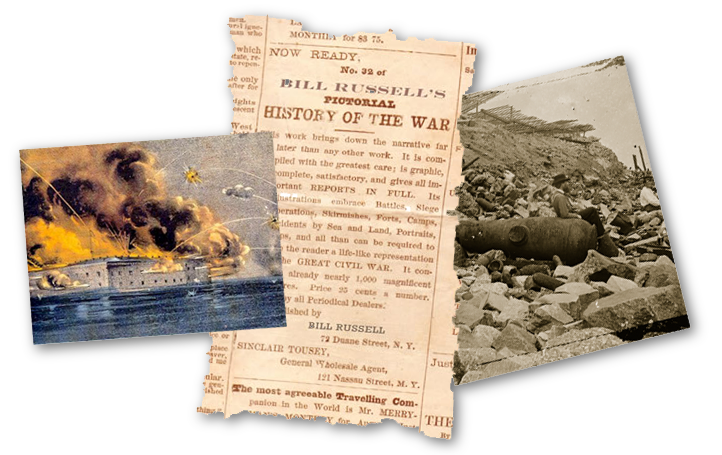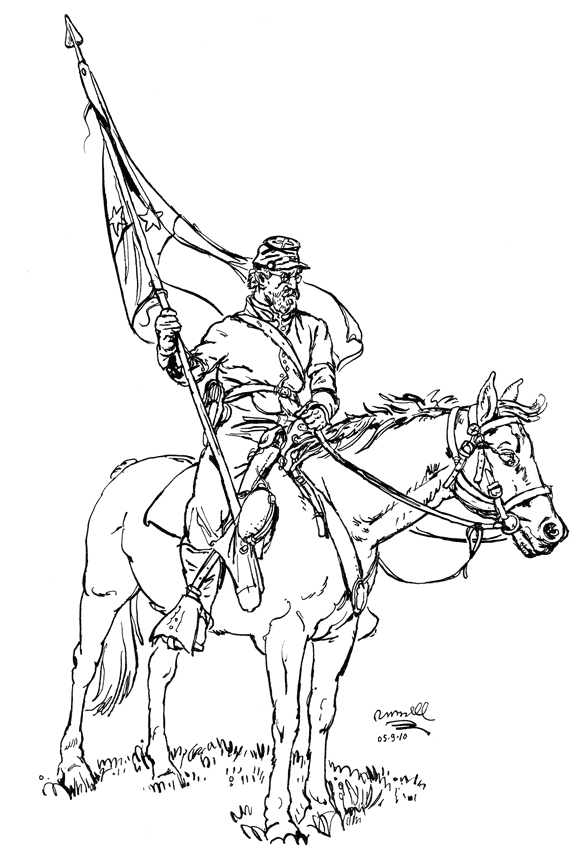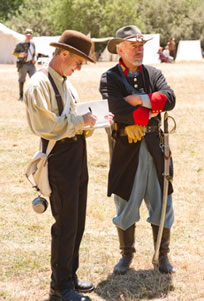Embedded with Civil War Reanactors: A Book Proposal by Bill Russell
Below is an introduction on how you can experience the battle with sketches and stories about Civil War Reenactors. There’s also a little of history and some prose, and a biography of the author and illustrator Bill Russell and how to contact him if you are interested in publishing this book.

Introduction: This book proposal essentially about later day Civil War soldiers presented by an embedded reporter artist.
The Proposal: Bill Russell, an award-winning visual journalist tackles the subject of the Civil War and how its history is actively replayed by scores of grown men and women on makeshift battlefields across the country called reenactments. Bill spent time with these hard-core buffs, who put on period clothes, educate the people who visit and reenact battles. He tells of their passion and their stories in drawings and illustrated text, as well as video and audio clips. He uncovers and examines the war’s contemporary meaning and how the war just ain’t over for them. The lasting legacy of North and South is a metaphor for the cultural battle present in America today. The Canadian-born author and illustrator brings the freshness of an outsider’s perspective as an embedded reporter artist for a newspaper of the day much like Fredrick Remington and Winslow Homer.
The Process: This reporter artist Bill Russell, embeds himself into the reenactment and covers the battle scene with sketchbook in hand, talking to reenactors, taking notes and drawing. He is not without modern technology, though. He pulls out his camera and takes shots of the people of whom he will later produce portraits. Videographer Richard Wheeler contributes his documentary video skills to capture these events.
What you get with this Book and eBook:
• An introduction shows a battle in progress with muskets being loaded, of feet hitting the ground, men yelling encouragement, orders to their gunners, the clanging of metal on metal, wagons and horses moving.
• See the reporter artist and reenactor himself covering the battle scene.
• A slideshow of sketches and stories, fading in and out, with the look of vintage and tattered paper. Bill talks about who reenactors are and in some cases, it dissolves into real-life photos, video or audio of that person in same exact local where they were sketched. Scene then moves to that person’s story. Music of the period plays.
• Reenactors come to life, rising up from their sketches. We see them explaining their vision, their intentions, and why they do it. Video and audio over stills correspond to what they are saying – i.e. about the historical detail, or the camaraderie, or a salute to the nation’s glorious past.
• You get the history of the movement told through the people themselves. Drawings and photographs of just about every side of the reenactor’s operations – not the battles as seen in the opening, but the paraphernalia and a look behind the scenes, a present day perspective told in visuals.
• Commentary on the meaning and the metaphors that will attempt to explain and explore the contemporary meaning of all this reenacted drama and how it is metaphor for the cultural fault-lines Bill sees in America today.
Technology: History brought to the present through today’s technology including an interface with the iPad and other tablet devices to deliver this eBook and app.
The Audience: Civil War Reenactors, American history buffs, and people interested in art and culture.
Why Bill? Why is Bill Russell qualified to make this multimedia book. This native of Canada sees America with the eye of an “outsider” but has been here long enough to know much about the American cultural milieu. This illustrator of many years, has sketched many man-in-the-street subjects for newspapers and commercial clients and has long held an interest in the Civil War and a curiosity about the life and motivations of these reenactors.
Marketing and Promotion: 2013 is the 150th anniversary of the beginning of the Civil War, with the bombardment of Ft. Sumter in Charleston, Virginia. Re-enactors live and breathe this stuff. History teaches us about how to greet the future.
Manuscript Specs: The goal is 40 drawings, 40 stories and 40 history lessons as well as some commentary.
Multimedia: The eBook and web version of the book allows for a variety of new media to tell this story, from a slideshow of sketches, fading in and out, with the look of vintage and tattered paper to audio of Bill talking to the reenactors themselves. Interactive photos, video and audio of that person or event and enhance the educational experience. Music of the
Meet the Reenactors:
Colonel Rod: This is my third visit with my local reenactor. Rod Collins of San Rafael, California is a Sergeant Major Emeritus. He stands over 6 feet tall, his long hair and beard white from age. He tows an oxygen tank to help his breathing. read more
Lt. Kermit Doesn’t Walk Well: First Lt. Kermit Albritton of the 2nd South Carolina Regiment is handicapped. He rides Fred, his palamino and carries the Confederate colors.
Home Front Wife, Donna Schulken: Donna is a Civil War wife and member of the Sanitation Corps. The men stay involved longer if the wives come along.
Battlefield Surgeon: Dr. Beudeaux is a battlefield surgeon for the Yankee boys. “I stop the bleeding, treat the pain with lodium (liquid heroin) and do triage.”
Ain’t No Loving: ‘Die in a gross military manner’, yells Capt. Loving of the 3rd Confederate Provisional Army of Arkansas, as he points to the backfield.
Blacksmiths: Steve Morgan and Jim Minyard of Clovis, California are blacksmiths. ‘Yonder Lies my Master Sleeping” plays on one of his gramophones as he makes metal house numbers.
The Colonel: Colonel Christopher A. Bowman is the Confederate Brigade Commander and deadly serious about this. To him it’s not a hobby.
Ray Arenholz is Hot for the Big Gun: Ray Arenholtz (right) operates the bellows of the Artificer, the traveling field forge, one of six still in operation.
Zouaves make a Easy Target: The colorful garb Private John Hess of the 114th Pennsylvania Volunteer Infantry wears.
Private Banjo: Ed Sims of Yuba City California made his tackhead banjo with an oak neck and sheep gut strings.
The Horses Died, Too: Susan Albritton cares for horses. “Horses charged the guns and died…3 and a half million horses, mules and oxen were killed in the Civil War.”
After the Battle, a Cigar: Lt. Colonel Bob Preston of the 9th Brigade, 2nd Army Corp of Northern Virginia says “cigars are my trademark.”
Grape Shot: Capt. Paul Vancas of the 1812 Artillary Regiment of Fayette Virginia shows me the “Bolt”, a 31 lb.Whitworth shell from a Howitzer. He says, “this grape shot has a 30 ft. kill radius.”
The Beard: Major Chiefy of the 43rd Virginia Cavalry strikes a unique profile with the long beard he’s had since ’66. “I started growin’ it after I arrived in San Francisco during the Summer of Love.”
Battle Cry: First Sargeant Scott Foster is a bugler and a fifer. “I send out the Colonel’s battlefield calls and play taps. It makes people cry.”
History:
Backstory: April 12, 2011 marked the 150th anniversary of the bombardment of Ft. Sumter in Charleston, South Carolina and the beginning of the Civil War. The Reenactor movement began just as the last Civil War veterans were dying off but recreations began to take hold 50 years ago with the formation of the National Civil War Association. Tony Horwitz’s book Confederates in the Attic talks about the beginning of the movement quite well.
This Book: tells the story of this movement through the eyes of an embedded artist with drawings and other media, prose and diary entries. He shows us a behind the scenes look at the reenactor operations – not just the history relived but the battles, the gear, the parafenalia, the personalities, the obsession, the politics and a present day perspective.
Some prose:
Spirit Whose Work is Done by Walt Whitman:

SPIRIT whose work is done- spirit of dreadful hours!
Ere departing fade from my eyes your forests of bayonets;
Spirit of gloomiest fears and doubts, (yet onward ever unfaltering
pressing,)
Spirit of many a solemn day and many a savage scene- electric
spirit,
That with muttering voice through the war now closed, like a
tireless phantom flitted,
Rousing the land with breath of flame, while you beat and beat the
drum,
Now as the sound of the drum, hollow and harsh to the last,
reverberates round me,As your ranks, your immortal ranks, return, return from the battles,
As the muskets of the young men yet lean over their shoulders,
As I look on the bayonets bristling over their shoulders,
As those slanted bayonets, whole forests of them appearing in the
distance, approach and pass on, returning homeward,
Moving with steady motion, swaying to and fro to the right and left,
Evenly lightly rising and falling while the steps keep time;
Spirit of hours I knew, all hectic red one day, but pale as death
next day,
Touch my mouth ere you depart, press my lips close,
Leave me your pulses of rage- bequeath them to me- fill me with
currents convulsive,
Let them scorch and blister out of my chants when you are gone,
Let them identify you to the future in these songs.
The Ballad of Chickamauga by Herman Melville:

They brushed the foe before them
(Shall gnats impede the hull?);
Their own good bridges bore them
Over swamps or torrents full,
And the grand pines waving o’er them
Bowed to axes keen and cool.
The columns grooved their channels,
Enforced their own decree,
And their power met nothing larger
Until it met the sea:
It was glorious glad marching,
A marching glad and free.
Kilpatrick’s snare of ridersIn zigzags mazed the land,
Perplexed the pale Southsiders
With feints on every hand;
Vague menace awed the hiders
In forts beyond command.
To Sherman’s shifting problem
No foeman knew the key;
But onward went the marching
Unpausing to the sea:
It was glorious glad marching,
The swinging step was free.
The flankers ranged like pigeons
In clouds through field or wood;
The flocks of all those regions,
The herds and horses good,
Poured in and swelled the legions,
For they caught the marching mood.
A volley ahead! They hear it;
And they hear the repartee:
Fighting was hut frolic
In that marching to the sea:
It was glorious glad marching,
A marching bold and free.
Metaphor:
Why reenact: They reenact from their core. To them, it’s meaning goes deep. Bill will attempt to explain the contemporary meaning of all this reenacted drama and how these metaphorical and cultural fault-lines are at play in America today.
The Politics of it all: Paul Mason, a commentator for the BBC, wrote that, “if the key to American politics before 1861 was a split into two demographically separate “nations” then the parallels today are uncomfortable.” He goes on to say that, “today the shadow of this division still looms, barely acknowledged, over America’s mid-term Congressional election, which has descended into a rancorous culture war with blasts of literal bellicosity at the edges.”
Before the Civil War, there was a sectional consciousness in America (not just with differing attitudes of slavery), with emotional and psychological implications, which made war inevitable. Today America’s two nations are divided by the unseen boundaries that segregate many American towns and cities along lines of color, lifestyle and class. Reenactors speak to this division and we need to hear from them.
About the author and illustrator:
 Visual journalist Bill Russell (shown at left) has been an illustrator, designer and writer for over 30 years. He recently completed a 4-month artist-in-residence at Recology San Francisco, where he drew 30+ employees and created a book and a set of prints telling their stories and the story of recycling. As a staff artist at the San Francisco Chronicle, Bill created several visual essays including the Bayfolk Sketchbook. At reenactments, he portrays London Times war correspondent named (coincidentally) Willy ‘Bull Run’ Russell. His account of the Union defeat at the first Battle of Bull Run made him unpopular, hence the moniker. Read his obit. More of Bill’s Civil War drawings can be found here. Bill’s address is 2074 Huckleberry Rd., San Rafael, CA 94903. Inquiries can be made by phone to 415.491.9734 or email: Bill (at) Billustration.com
Visual journalist Bill Russell (shown at left) has been an illustrator, designer and writer for over 30 years. He recently completed a 4-month artist-in-residence at Recology San Francisco, where he drew 30+ employees and created a book and a set of prints telling their stories and the story of recycling. As a staff artist at the San Francisco Chronicle, Bill created several visual essays including the Bayfolk Sketchbook. At reenactments, he portrays London Times war correspondent named (coincidentally) Willy ‘Bull Run’ Russell. His account of the Union defeat at the first Battle of Bull Run made him unpopular, hence the moniker. Read his obit. More of Bill’s Civil War drawings can be found here. Bill’s address is 2074 Huckleberry Rd., San Rafael, CA 94903. Inquiries can be made by phone to 415.491.9734 or email: Bill (at) Billustration.com
